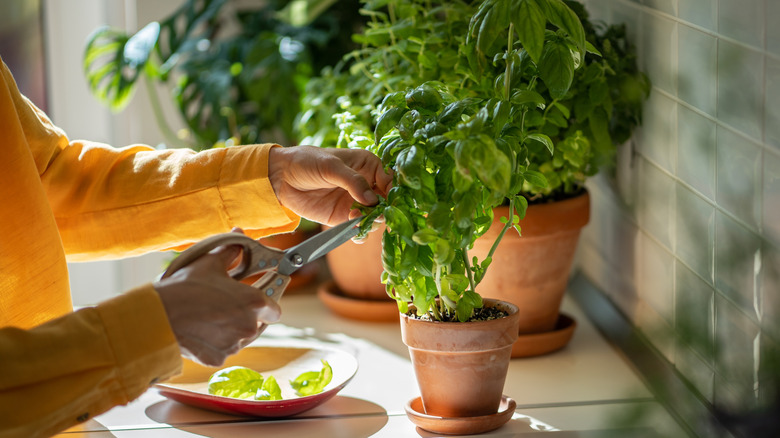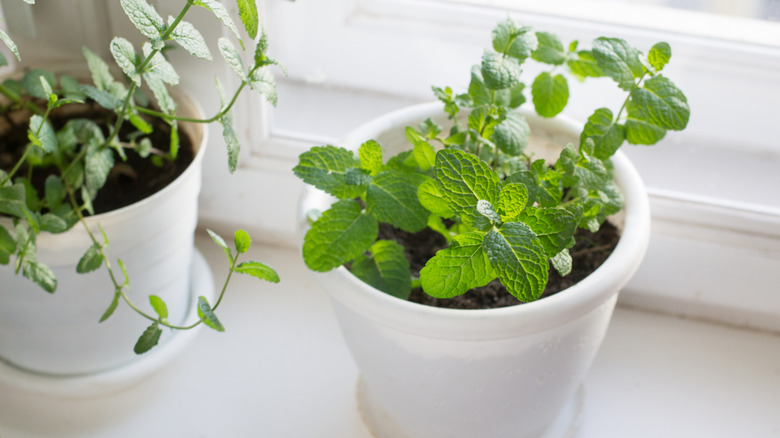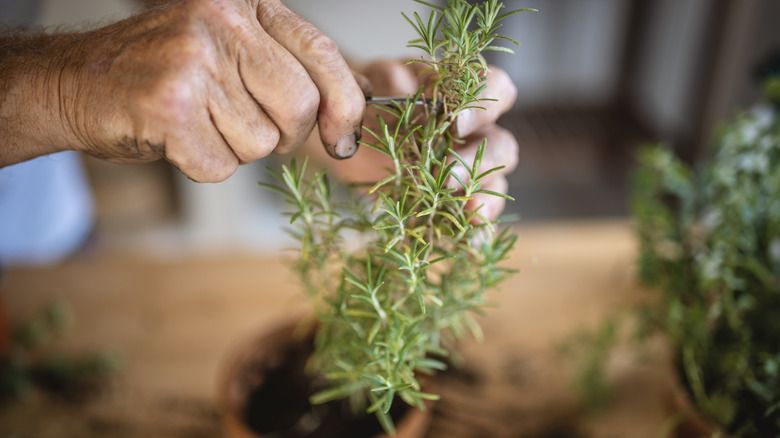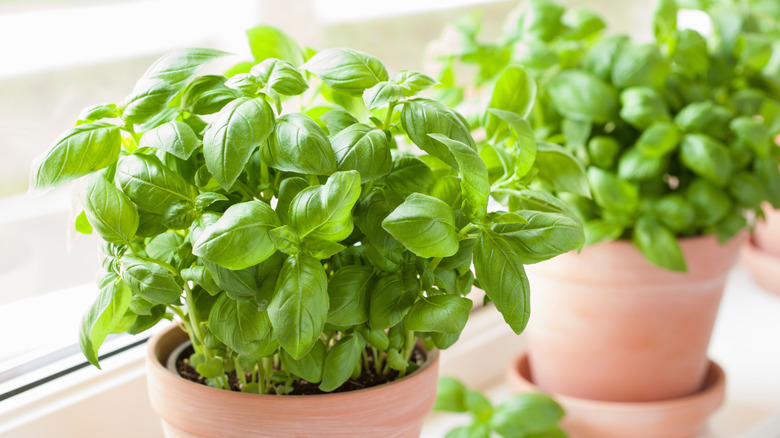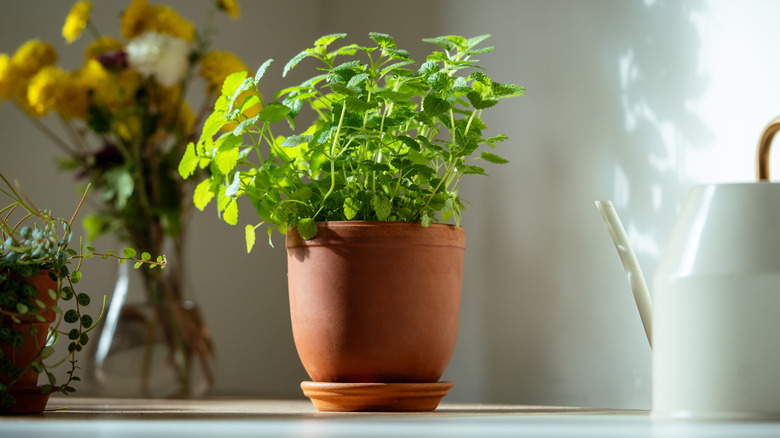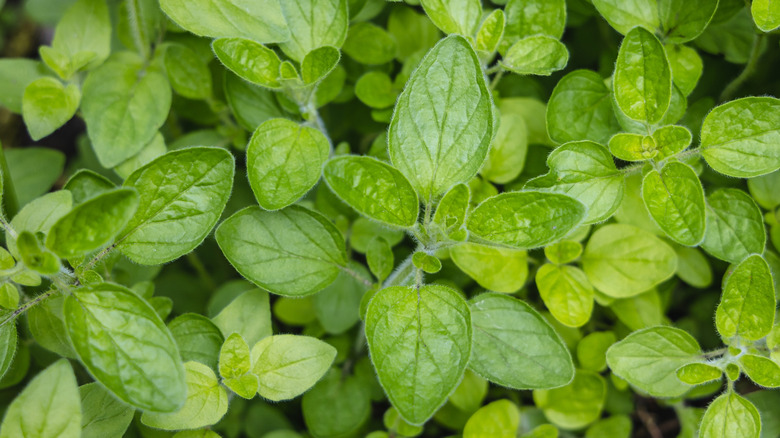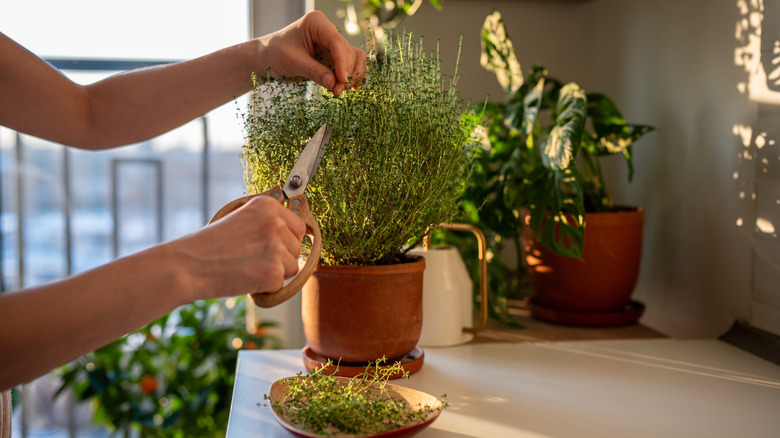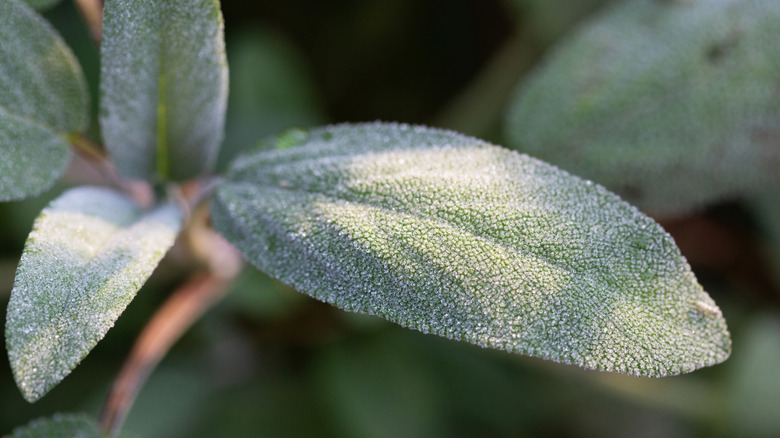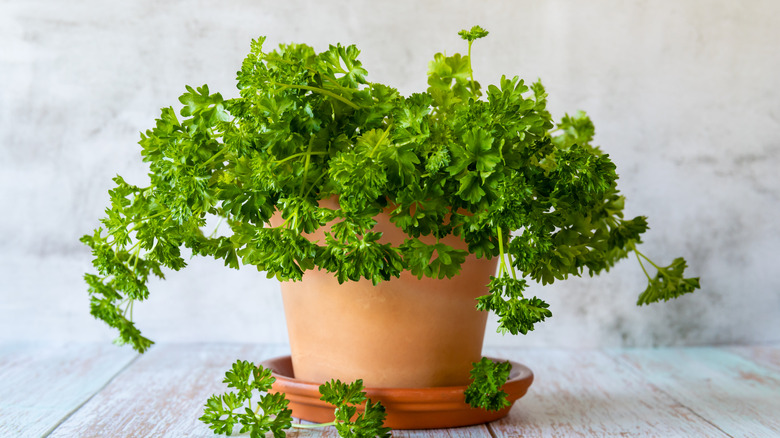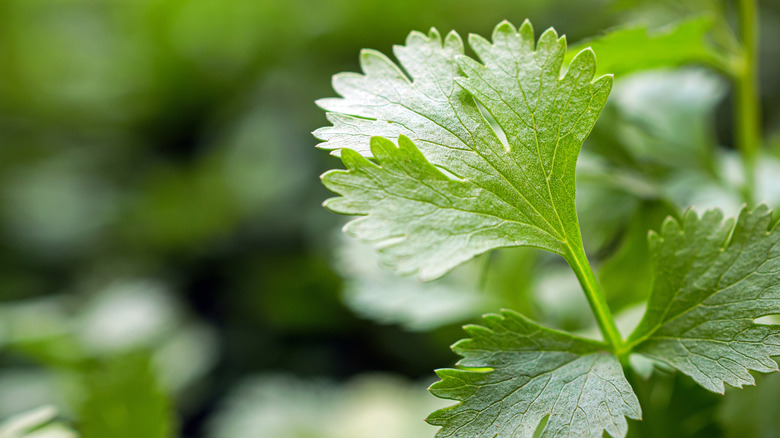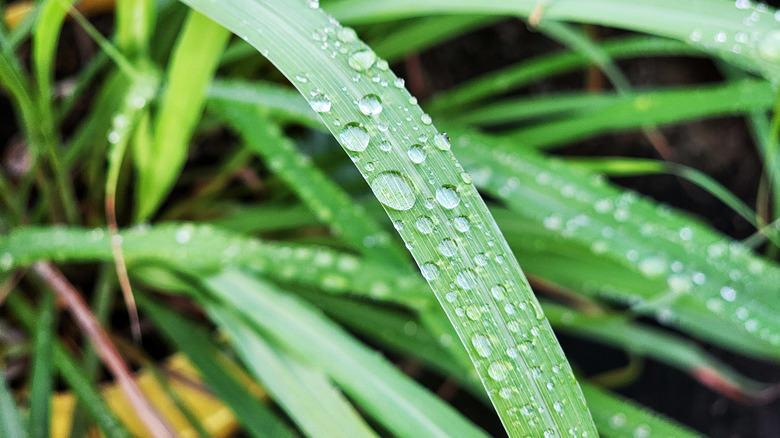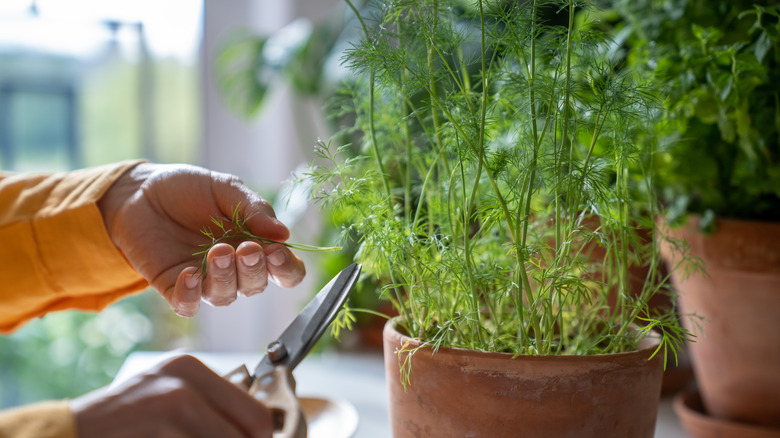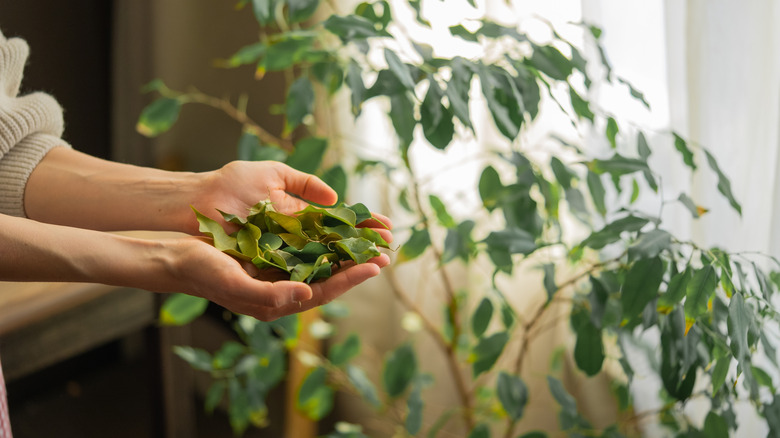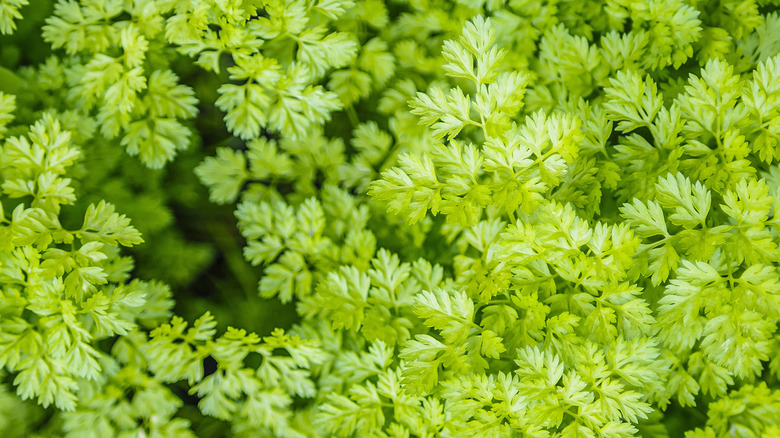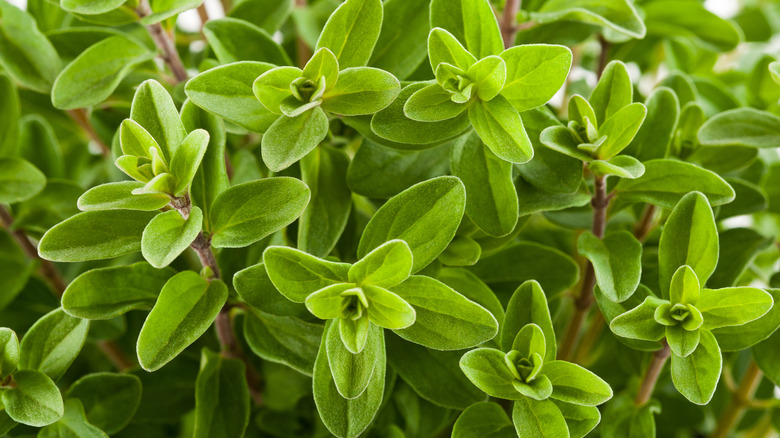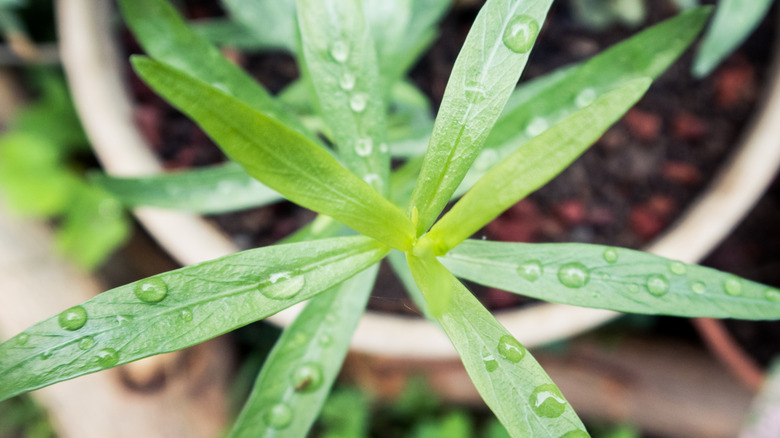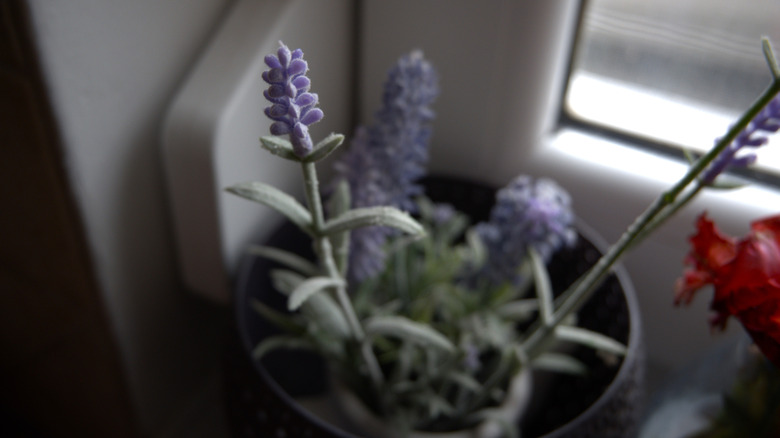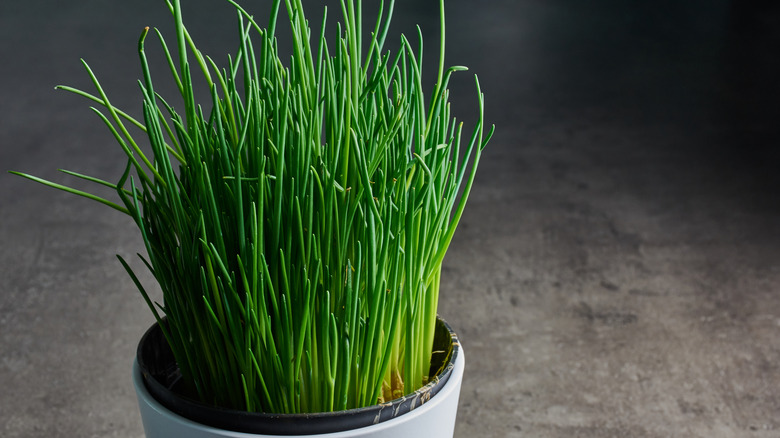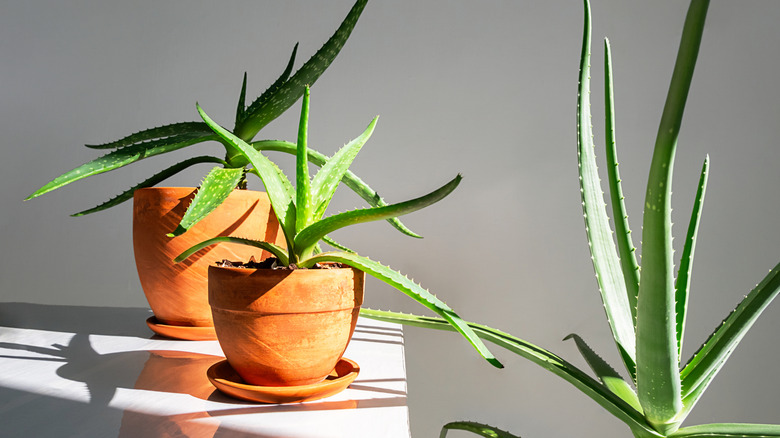18 Herbs That Grow Successfully Indoors During Winter
Part of the joy of gardening is getting to enjoy the fruits of your labor, whether that's vegetables fresh out of the garden or elaborate courses garnished with herbs you grew yourself. However, winter's chilly approach can make it seem like your time enjoying fresh herbs is up for the year, leaving you to rely on dried or store-bought flavors. Don't stock your cabinets just yet, though — there are some herbs you can grow successfully indoors, even throughout the colder months of the year.
When starting your indoor herb garden, you have two options for acquiring your plants. First, you can start from scratch by growing your new herbs from either seeds and cuttings, or you can simply purchase an established plant. You can also move many of your herbs from your outdoor garden inside. To do so, gently dig up your herbs, being careful not to harm the roots, before your first frost and repot them. However, you may need to adjust your care routine once your herbs are indoors, such as relying on south-facing windows for optimal sunlight in the northern hemisphere or supplementing with a grow light as needed. It's also important to choose the right plant. Fortunately, from mint and chives to more uncommon picks like lavender and aloe vera, there is a wide variety of herbs that you can successfully grow indoors this winter.
Mint
Fragrant and easy to grow, mint (Mentha spp.) can be a great choice if you're looking for herbs to grow indoors this winter. While it may go dormant in the winter, when brought inside and given adequate care, you can enjoy this herb all season long. However, one thing to keep in mind is mint's sunlight requirements. For best growth, aim for full sun exposure each day, although mint can survive when only given partial shade. Lack of sunlight, or exposure to colder temperatures, could cause it to stop growing.
Rosemary
Another fragrant herb to brighten up your home, rosemary (Salvia rosmarinus), is often grown for not only its use in cooking, but also for its value as an ornamental plant thanks to its many blooms. In warm climates, rosemary often grows into large shrubs, so you may not be able to readily move an existing plant indoors. Inside your home, regular harvesting can keep rosemary compact, while full sun and the right amount of watering keep it healthy. Potted rosemary can be trickier than its outdoor counterpart when it comes to water, so be aware of waterlogged or soggy soil.
Basil
From sauces to soup, basil (Ocimum basilicum) is an essential part of many culinary dishes. And it just so happens to be one of the best herbs to grow indoors during the winter as well. Basil is only hardy in a single zone (USDA zone 10), so bringing this tasty herb indoors lets you enjoy its flavor longer. However, like with mint and rosemary, it also needs full sun. This means that you may need to supplement with grow lights during those cloudy winter days. Overall, basil is one of the best herbs to grow in your kitchen.
Lemon balm
A member of the mint family, lemon balm (Melissa officinalis) has the tendency to grow aggressively, which is one reason that it does so well in containers. It has the faintest smell of lemon, which can brighten up those winter days spent longing for summer. Overall, lemon balm isn't picky about soil so long as it's well-draining, and it can grow in partial shade (although full sun is best). One thing to keep in mind is that regular harvesting is a must with this plant, especially if you want to limit its spread in your container.
Oregano
Indoor herb gardens can provide many benefits outside of cooking, even if it's just to hone your green thumb outside of the typical growing season. However, if you are interested in growing herbs specifically for cooking, oregano (Origanum spp.) is a must-have. Like many herbs, oregano has aromatic leaves, and while winter may be spent with green leaves alone, you can enjoy delicate pink or white flowers if you put it outside in the summer. You can grow this herb alongside other common picks, like sage or thyme, so long as you give it the full sun it needs.
Thyme
Thyme (Thymus vulgaris) can be a bit more picky than other common indoor herbs when it comes to care. It's more specific about its soil preferences, growing best in dry or rock soil with good drainage, and it needs regular trimming. Fortunately, aside from these qualities, thyme is easy to grow, making it a perfect plant for beginners, and otherwise low-maintenance. For the best results while growing thyme, like with many other herbs on this list, aim for full sun exposure each day.
Sage
One reason that sage (Salvia officinalis) can be grown beside thyme is that it needs the same dry soil conditions with plenty of sunlight. In fact, you'll find that wet or waterlogged soil with poor drainage increases the risk of disease. Sage needs to be pruned, but not until spring, and you can propagate healthy cuttings for more sage plants to grow indoors during the winter. Harvest individual leaves as needed. Keep in mind that this species can be used for extra flavor in your favorite dishes, but not all sage is suited for culinary purposes.
Parsley
Parsley (Petroselinum crispum) comes in a range of varieties, from flat leaf to curly leaf. As a result, when looking for the right herb to add to your indoor garden this winter, you have options to choose from depending on your preferred appearance and usage. Parsley actually does best when planted indoor during the cooler months of fall and winter, which means you can start this plant from scratch indoors and enjoy watching its growth. Along with partial or full sun, growing and caring for parsley also requires regular fertilization.
Cilantro
Compared to outdoors, growing cilantro (Coriandrum sativum) in your home can be tricky. However, with a few adjustments in your care strategy, you can readily enjoy this herb indoors throughout the winter and rest of the year. One major thing to keep in mind, especially while you have the heat going, is temperature. Fortunately, cilantro does best when grown between 50 and 80 degrees Fahrenheit — a range that makes it perfect for growing indoors. It also requires full sun and regular pruning for optimal growth.
Lemongrass
Lemongrass (Cymbopogon citratus) isn't the same as lemon balm, though the two herbs share similar names and scents. As a result, if you're looking to curate an indoor container garden over the winter that feels like summer, pairing these two plants can be a step in the right direction. Visually, lemongrass is a subtle plant, with green stems and no flowers. It needs three factors to thrive: warm temperatures, humidity, and partial or full sun exposure. As a result, if your heater is leaving the air dry, you may also want to opt for a humidifier in your home.
Dill
Dill (Anethum graveolens) can be used in a variety of projects, from cooking and pickling to floral arrangements. As a result, it can be a popular pick for indoor herbs. However, there are various types of dill available, so it's important to pick a variety that doesn't just fit your desired usage but also indoor growing conditions. When growing dill, aim for at least six hours of sunlight each day. Moist soil is best, but it's essential to avoid overwatering. It does produce flowers, but allowing it to bolt and produce seeds will lead to this plant's death.
Bay laurel
When it comes to bay laurel (Laurus nobilis), you may be more familiar with one of its other names, like bay leaf or sweet bay. One thing that's unique for bay laurel compared to other herbs discussed so far is that this plant is an evergreen tree. Luckily, while it can grow to be 60 feet tall in the wild, it does well indoors, and growing bay in a pot even provides additional mobility that can be helpful for fulfilling its sunlight needs of partial shade or full sun. Just prepare for root pruning to manage its size.
Chervil
Chervil (Anthriscus cerefolium) is a relative to parsley, although it thrives in cooler weather. While chervil is an annual, it does produce seeds. As a result, you can replant your chervil season after season for year-round access to this culinary essential. In fact, because transplanting chervil can be difficult due to its roots, growing from seed is one of the most common ways to acquire this herb. Like parsley, chervil can grow in partial or full sun. However, you'll want to provide it with moist but well-draining soil.
Marjoram
Marjoram (Origanum majorana) sports a tolerance for droughts and warmer weather, but cold spells are a no-go for this flowering herb. As a result, choosing an indoor planter is the best way to enjoy marjoram during the winter. One of the major diseases to keep an eye out for with marjoram is root rot, along with some pest concerns. As a result, good draining is key for optimal growth. If you need the perfect place to display this eye-catching herb, opt for a spot with plenty of light as it also needs full sun.
Tarragon
For those in search of a French herb to grow indoors year-round, look no further than French tarragon (Artemisia dracunculus French). You can also grow its more subtle-flavored relative, Russian tarragon (A. dracunculus Russian) indoors. French tarragon, however, cannot be grown from seed. Instead, you'll need to propagate cuttings. Fortunately, regular pruning can provide ample healthy samples, helping you cultivate a thriving indoor garden. When growing tarragon, full sun and well-draining soil on the drier side are key ingredients for healthy plants.
Lavender
When thinking about herbs, especially those to grow inside during the winter, lavender (Lavandula angustifolia) may not be the first to come to mind. However, so long as you choose the right variety, lavender can make an excellent houseplant with various uses. It may require some extra care and attention to detail, though. For example, lavender can be susceptible to leaf spot and root rot, especially with the common lavender mistake of overwatering, so you may want to use a terracotta pot for ample drainage and airflow. It also needs 6 to 8 hours of sunlight every day.
Chives
An edible plant that produces eye-catching purple flowers, chives (Allium schoenoprasum) can do it all. And the best part? It can be one of the easiest herbs to grow, making it the perfect choice for beginner gardeners who aren't sure where to start in their indoor herb garden. Full sun is ideal, but if you don't have a window with ample light or a grow light, partial sun can also work. They can handle drought as well, although consistent watering can be helpful during the growing season. Once they mature and become well-established, chives require little care, making them a low-maintenance choice.
Aloe vera
While it may seem surprising, aloe vera (Aloe vera barbadensis) is an herb — and a popular one at that. Similar to other types of succulents, aloe vera produces overall smooth but fleshy leaves rather than the flat leaves you often see with herbs. However, each leaf often sports an edge covered in serrated spikes, which gives aloe a unique appearance. If you want to grow aloe inside, full sun can help support healthy growth, with some light shade also tolerated. However, while sunlight is a necessity, aim for indirect light, as direct light can cause the leaves to turn brown.
